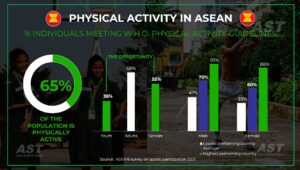In today’s fast-paced, technology-driven world, it is becoming increasingly difficult for people to remain engaged in their communities. This disconnect is particularly evident among two critical age groups: the youth and seniors. Fast rising obesity rates, coupled with an increase in sedentary lifestyles have helped to compound this problem.
There was a 28% drop in the average step count globally in the first two months of the pandemic (The Lancet), and the average time spent by children on screens in the USA increased by 50% during the pandemic (Kaiser Family Foundation). This has opened a pandora’s box of problems, chief amongst them being increased healthcare costs. In Asia, we will see an outsized impact with an increasingly aging population, with people aged 65+ going from 7% in 2020 to 16% in 2050 (United Nations).
To remedy this situation, we must turn to an activity that has the power to unite generations: sports. By leveraging sports to power education and participation, we can re-engage the youth and seniors, helping them build stronger connections and foster a sense of belonging within their communities.

The Power of Sports
Sports have long been known to contribute to the physical, mental, and social well-being of individuals. They not only provide a means of exercise, but also create opportunities for social interaction and the development of valuable life skills. By engaging in sports, participants can learn teamwork, discipline, and perseverance, while also building self-esteem and a sense of accomplishment.
Studies have shown that for the youth, participation in sports can improve academic performance, increase self-esteem, and reduce the risk of chronic illnesses such as obesity and diabetes. For seniors, sports can help prevent falls, improve cognitive function, and reduce the risk of depression and isolation.
For young people, involvement in sports can be especially beneficial. It has been proven that participation in sports can lead to better performance in school and a reduced likelihood of engaging in risky behaviors. For seniors, taking part in physical activities can help maintain cognitive function, improve emotional well-being, and mitigate the risk of chronic diseases.

Bridging the Gap: Youth and Seniors
Despite the numerous benefits that sports offer, many young people and seniors remain disengaged from their communities and are not participating in physical activities. To effectively address this issue, we must create opportunities that cater to the unique needs and preferences of these age groups.
Encouraging Youth Participation

To re-engage the youth, it is crucial to make sports more accessible and appealing. This can be achieved through the following strategies:
- Integrating sports into the education system: By incorporating sports into the school curriculum, we can ensure that young people receive regular exposure to physical activity. This can also help foster an appreciation for sports and encourage lifelong participation.
- Offering a variety of sports: Providing a diverse range of sports options can cater to the interests of different individuals, increasing the likelihood that young people will find a sport they enjoy and want to pursue.
- Creating safe and supportive environments: Encouraging a positive sporting culture that involves coaching, mentoring, and peer support can help young people feel more comfortable participating in sports and reduce the risk of negative experiences, such as bullying or injury.
- Sports-based education programs can help improve academic performance by providing opportunities for learning beyond the traditional classroom. For example, programs that combine sports with science, technology, engineering, and math (STEM) education can help students develop critical thinking and problem-solving skills while also promoting physical activity. Similarly, programs that combine sports with social and emotional learning (SEL) can help students develop important life skills such as communication, teamwork, and resilience. By providing opportunities for youth to develop these skills in a fun and engaging environment, we can help them build the foundation for a successful future.
Engaging Seniors
 To involve seniors in sports, we must ensure that the activities available are appropriate and enjoyable for their age group. Some ways to achieve this include:
To involve seniors in sports, we must ensure that the activities available are appropriate and enjoyable for their age group. Some ways to achieve this include:
- Promoting age-friendly sports programs: Designing sports programs specifically for seniors can help create a more inclusive environment, where participants feel comfortable and supported.
- Focusing on low-impact sports: Offering low-impact sports, such as swimming, walking, yoga, or even pickleball, can help seniors maintain their physical health without placing excessive strain on their bodies.
- Creating opportunities for intergenerational interaction: Encouraging intergenerational sports programs can provide seniors with a chance to interact with younger generations, fostering a sense of connection and belonging within the community.
- Sports-based programs: Provide opportunities for socialization and engagement while also promoting physical and mental health. Programs that combine sports with wellness activities such as yoga or meditation can help seniors maintain their physical and mental health, while also providing opportunities for social interaction and community building.
Similarly, programs that combine sports with volunteering or community service can help seniors stay engaged and connected to their communities. By providing opportunities for seniors to give back and make a difference, we can help them maintain a sense of purpose and fulfillment in their later years.
The Role of Technology
To further enhance the potential of sports in re engaging the youth and seniors, we must harness the power of technology. By using digital platforms and tools, we can create innovative and engaging sports experiences that cater to the interests of these age groups.
- Digital Platforms for Learning and Engagement: Technology can be used to create digital platforms that provide access to sports-based educational content and activities, such as tutorials, quizzes, and interactive games. These platforms can engage youth and seniors in educational activities that are fun and motivating, while also promoting physical activity.
- Wearable Technology for Tracking and Monitoring: Wearable technology, such as fitness trackers and sensors, can be used to monitor and track physical activity levels and provide feedback to users. This technology can motivate youth and seniors to be more active and provide them with data-driven insights into their progress.
- Virtual Reality and Augmented Reality: Virtual and augmented reality technology can be used to create immersive sports experiences that allow youth and seniors to participate in sports activities virtually. These technologies can also be used to create educational content that enhances learning and understanding of sports-related concepts.
- Social Media and Online Communities: Social media platforms and online communities can be used to connect youth and seniors with others who share their interest in sports and physical activity. These platforms can provide a supportive environment for learning, sharing ideas, and building relationships.
- Mobile Applications: Mobile applications can be developed to enable youth and seniors to participate in sports-based activities, such as challenges, competitions, and games. These applications can be customized to meet the needs of different age groups and skill levels, and can provide users with a fun and engaging way to stay active.
Reengaging the youth and seniors is crucial for the health and vitality of our communities. By leveraging sports to power education and participation, we can create opportunities for these age groups to connect, learn, and thrive. By integrating sports into the education system, offering diverse sports options, and using technology to enhance the sporting experience, we can foster a sense of belonging and empower individuals to lead healthier, more fulfilling lives.
By creating programs that combine sports with education, wellness, and community engagement, we can provide opportunities for individuals to develop the skills they need to succeed both on and off the field. And by making these programs accessible and inclusive, we can ensure that all individuals have the opportunity to participate and benefit from sports.
Reach out to us to learn about how to measure the impact of your purpose-driven sport sponsorships.



